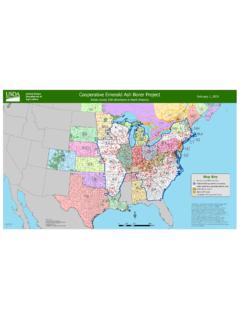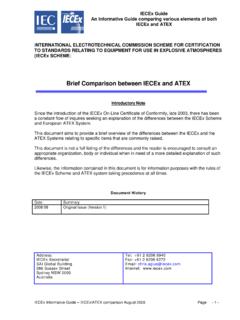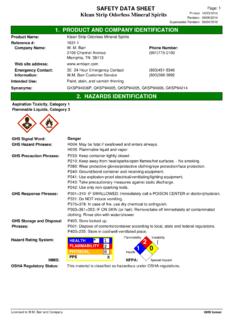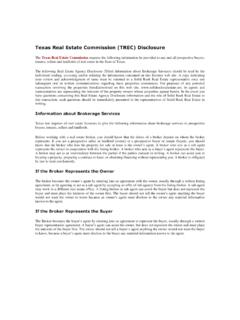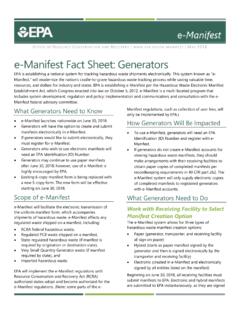Transcription of The Third Unregulated Contaminant Monitoring Rule (UCMR …
1 Office of Water (MS-140) EPA 815-S-17-001 January 2017 The Third Unregulated Contaminant Monitoring Rule (UCMR 3): Data Summary, January 2017 EPA uses the Unregulated Contaminant Monitoring Rule (UCMR) program to collect data for contaminants suspected to be present in drinking water, but that do not have health-based standards set under the Safe Drinking Water Act (SDWA). Every five years EPA develops a new list of UCMR contaminants, largely based on the Contaminant Candidate List (CCL). The SDWA Amendments of 1996 provide for: Monitoring no more than 30 contaminants per 5-year cycle Monitoring only a representative sample of public water systems (PWSs) serving less than or equal to10,000 people Storing analytical results in a National Contaminant Occurrence Database (NCOD)UCMR 3 required Monitoring for 30 contaminants (28 chemicals and two viruses) between 2013 and 2015 using analytical methods developed by EPA, consensus organizations or both. This Monitoring provides a basis for future regulatory determinations and/or other actions to protect public health.
2 This dataset represents the twelfth and final NCOD release of analytical results for UCMR 3. Additional reference material is available to assist with the assessment of the UCMR 3 data. EPA s UCMR 3 website Instructions for importing and viewing UCMR 3 results Additional information for the UCMR 3 contaminants on the CCL & Regulatory Determination websiteUCMR 3 Data Considerations To perform additional data analyses, EPA suggests importing each field into your choice of software as text. Some of the IDs can be misinterpreted as long integer field types when they actually contain alpha characters. Data are presented as tab delimited text files, with field names included in the first row of each file and no text qualifier: Select UCMR 3 Occurrence Data to find the text file containing ALL results to date ( ) Select UCMR 3 Occurrence Data by State to find the text files containing ALL results to date for tribes and states AK-LA ( ) and states MA-WY ( ) Select UCMR 3 Occurrence Data by Method Classification to find method-specific text files( , example UCMR3_200_8 for EPA method ) Text file containing disinfectant type ( ) Text file containing the Postal Service zip code(s) for all areas served by a PWS( ) Samples collected at the maximum residence time in the distribution system (MR) were required to be analyzed for metals (including chromium-6) and chlorate.
3 PWSs Monitoring for Method (chlorate) reported disinfectant types. In addition to reporting occurrence data for UCMR 3 target analytes, EPA tasked its small-system contract-support laboratories with reporting results for sec-butylbenzene, n-propylbenzene, tellurium, germanium and manganese. These additional Unregulated analytes are within the scope of the methods already being performed for the UCMR analytes. Population categories are based on retail population as indicated by the Safe Drinking Water Information System (Federal) (SDWIS/FED) as of December 31, 2010. UCMR 3, January 2017 Page 2 of 12 UCMR 3 Data Field Names and Definitions Field Name Definition PWSID Public Water System Identification Code, 9-character identification code (Begins with the standard 2-character postal State abbreviation or Region code, and the remaining seven numbers are unique to each PWS in the state) PWSName Name of the Public Water System (PWS) Size Size category of the PWS for UCMR, based on retail population as of December 31, 2010: S ( 10,000), L (> 10,000) FacilityID Public Water System Facility Identification Code, 5-digit identification code FacilityName Name of the facility at the PWS FacilityWaterType Source of water at the facility: SW (surface water), GW (ground water), GU (ground water under the direct influence of surface water), MX (Any combination of.)
4 SW, GW and GU) SamplePointID Identification code for each sample point location in the PWS SamplePointName Name of the sample point for every sample point ID at a PWS SamplePointType Sampling Point Type Code: EP (entry point to the distribution system), MR (distribution system at maximum residence time)AssociatedFacilityID The facility ID of the associated MR AssociatedSamplePointID The sample point ID of the associated MR Disinfectant Type CLGA (Gaseous Chlorine), CLOF (Offsite Generated Hypochlorite, stored as liquid), CLON (Onsite Generated Hypochlorite, no storage), CAGC (Chloramine, formed from gaseous chlorine), CAOF (Chloramine, formed from offsite hypochlorite), CAON (Chloramine, formed from onsite hypochlorite), CLDO (Chlorine Dioxide), OZON (Ozone), ULVL (Ultraviolet Light), OTHD (All other types of disinfectant), NODU (No Disinfectant Used) CollectionDate Date of sample collection (month, day, year) SampleID Identification code for each sample, as defined by the laboratory Contaminant Unregulated Contaminant being analyzed in UCMR 3 MRL Minimum Reporting Level defined by UCMR 3 in g/L for the chemicals UCMR 3, January 2017 Page 3 of 12 Field Name Definition MethodID Identification code of the analytical method AnalyticalResultsSign Less than (<) the minimum reporting level (MRL) or equal to (=) a numeric value at or above the MRL AnalyticalResultValue Numeric value of the analytical result in g/L for the chemicals, null values represent less than MRL SampleEventCode Identification code for each sample event.
5 Includes sample event one (SE1), sample event two (SE2), sample event three (SE3), and sample event four (SE4). MonitoringRequirement AM (Assessment Monitoring , List 1), SS (Screening Survey, List 2), PST (Pre-Screen Testing, List 3) Region EPA Region (States): 1 (CT, ME, MA, NH, RI, VT), 2 (NJ, NY, PR (Puerto Rico), VI (Virgin Islands)), 3 (DE, DC, MD, PA, VA, WV), 4 (AL, FL, GA, KY, MS, NC, SC, TN), 5 (IL, IN, MI, MN, OH, WI), 6 (AR, LA, NM, OK, TX), 7 (IA, KS, MO, NE), 8 (CO, MT, ND, SD, UT, WY), 9 (AZ, CA, HI, NV, AS (American Samoa), GU (Guam), MP (Northern Marianas Islands), NN (Navajo Nation)), 10 (AK, ID, OR, WA) State State abbreviation ZipCode Postal Service zip code(s) for all areas being served water by a PWS UCMR 3, January 2017 Page 4 of 12 UCMR 3 Chemical Contaminants and Methods Contaminant Contaminant Full Name CAS1 Number Method ID Method Name Monitoring Requirement 1,2,3-trichloropropane 1,2,3-trichloropropane 96-18-4 Volatile Organic Compounds AM 1,3-butadiene 1,3-butadiene 106-99-0 Volatile Organic Compounds AM Chloromethane methyl chloride 74-87-3 Volatile Organic Compounds AM 1,1-dichloroethane 1,1-dichloroethane 75-34-3 Volatile Organic Compounds AM Bromomethane methyl bromide 74-83-9 Volatile Organic Compounds AM HCFC-22 chlorodifluoromethane 75-45-6 Volatile Organic Compounds AM Halon 1011 bromochloromethane 74-97-5 Volatile Organic Compounds AM 1,4-dioxane 1.
6 4-dioxane 123-91-1 522 Synthetic Organic Compound AM Vanadium vanadium 7440-62-2 Metals AM Molybdenum molybdenum 7439-98-7 Metals AM Cobalt cobalt 7440-48-4 Metals AM Strontium strontium 7440-24-6 Metals AM Chromium total chromium N/A Metals AM Chromium-6 chromium-6 18540-29-9 Chromium-6 AM Chlorate chlorate 14866-68-3 Oxyhalide Anion AM PFOS perfluorooctanesulfonic acid 1763-23-1 537 Perfluorinated Compounds AM PFOA perfluorooctanoic acid 335-67-1 537 Perfluorinated Compounds AM PFNA perfluorononanoic acid 375-95-1 537 Perfluorinated Compounds AM PFHxS perfluorohexanesulfonic acid 355-46-4 537 Perfluorinated Compounds AM PFHpA perfluoroheptanoic acid 375-85-9 537 Perfluorinated Compounds AM PFBS perfluorobutanesulfonic acid 375-73-5 537 Perfluorinated Compounds AM 17 -estradiol estradiol 50-28-2 539 Hormones SS 17 -ethynylestradiol ethinyl estradiol 57-63-6 539 Hormones SS Estriol 16- -hydroxyestradiol 50-27-1 539 Hormones SS Equilin equilin 474-86-2 539 Hormones SS Estrone estrone 53-16-7 539 Hormones SS Testosterone testosterone 58-22-0 539 Hormones SS 4-androstene-3,17-dione 4-androstene-3,17-dione 63-05-8 539 Hormones SS 1 Chemical Abstract Service UCMR 3, January 2017 Page 5 of 12 UCMR 3 Microbiological Contaminants and Methods Contaminant Method ID Method Name Monitoring Requirement Enteroviruses EPA 1615A Enterovirus cell culture PST Enteroviruses EPA 1615B Enterovirus RT-qPCR PST Noroviruses EPA 1615C Norovirus genogroup I with RT-qPCR primer set A PST Noroviruses EPA 1615D Norovirus genogroup I with RT-qPCR primer set B PST Noroviruses EPA 1615E Noroviruses genogroup II PST Total coliforms SM 9223B Colilert PST SM 9223B Colilert PST Enterococci ASTM D6503-99 Enterolert PST Aerobic spores SM 9218 Aerobic endospores PST Somatic phage EPA 1602 Bacteriophage PST Male specific phage EPA 1602 Bacteriophage PST UCMR 3.
7 January 2017 Page 6 of 12 UCMR 3 Reference Concentrations for Chemical Contaminants For the Third Unregulated Contaminant Monitoring Rule (UCMR 3) chemicals were being studied at levels that were often significantly below those in prior UCMR cycles. Importantly, UCMR 3 minimum reporting levels (MRLs) were established based on the capability of the analytical method, not based on a level established as significant or harmful. In fact, the UCMR 3 MRLs are often below current health reference levels (to the extent that HRLs have been established). Results of UCMR 3 measurements should be interpreted accordingly. The detection of a UCMR 3 Contaminant above the MRL does not represent cause for concern, in and of itself. Rather, the implications of the detection should be judged considering health effects information (which is often still under development or being refined for Unregulated contaminants). The intent of the following table is to identify draft UCMR reference concentrations, where possible, to provide context around the detection of a particular UCMR Contaminant above the MRL.
8 The draft reference concentration does not represent an action level (EPA requires no particular action1,2 based simply on the fact that UCMR Monitoring results exceed draft reference concentrations), nor should the draft reference concentration be interpreted as any indication of an Agency intent to establish a future drinking water regulation for the Contaminant at this or any other level. Decisions as to whether or not to regulate the Contaminant in drinking water will continue to be made following the Agency s Regulatory Determination process. Visit EPA s Regulatory Determination website for more information. The following key principles guided the development of the table: (1) The reference concentrations are based on publically-available health information found in the following EPA resources: 2012 Drinking Water Standards and Health Advisories, the CCL 4 Contaminant Information Sheets, the Human Health Benchmark for Pesticides (HHBPs), the Integrated Information Risk System (IRIS), or the 2014 Preliminary Regulatory Determinations for Contaminants on CCL 3.
9 The primary/secondary sources of health information vary with respect to scientific rigor from health assessment to single studies and are cited in the table. (2) If health information was available from more than one of the EPA resources listed above, the most recent health information was used for the draft reference concentrations. (3) Where both cancer and non-cancer draft reference concentrations existed, the lower (more conservative) of the two concentrations was used. For chemicals with reference concentrations based on a cancer endpoint, the table presents a range of values associated with 10-6 to 10-4 cancer risk. For chemicals with reference concentrations based on a non-cancer endpoint, the duration of exposure (short-term, intermediate/long-term, chronic) of the toxicity factor ( , Reference Dose) used as the basis for the reference concentration is shown. Recognizing that additional health effects information will become available over time, those attempting to assess UCMR occurrence data are encouraged to visit EPA s Drinking Water Contaminant Human Health Effects Information website for the most recent information.
10 1 Consumer Confidence Report (CCR) and Public Notification (PN) reporting requirements (see 40 CFR (d) and , respectively) apply to PWSs; CCR requires particular reporting based on measurements relative to the UCMR method reporting limits (MRLs) defined in 40 CFR 2 States may establish requirements for drinking water contaminants not yet regulated by EPA, and those requirements may be based on state-established levels that differ from EPA s reference concentrations. PWSs are responsible for being aware of and complying with their state s requirements, if any. UCMR 3, January 2017 Page 7 of 12 Contaminant MRL ( g/L) Reference Concentration ( g/L) Reference Concentration based on a Cancer Endpoint (Y/N) EPA Reference(s) Cobalt 1 70 N (intermediate exposure) CCL 4 Contaminant Information Sheets Molybdenum1 1 40 N (chronic exposure) 2012 Edition of the Health Advisories Table Strontium2 1,500 N (chronic exposure) Federal Register Notice for the Preliminary Regulatory Determinations for Contaminants on CCL 3 Vanadium3 21 N (intermediate exposure) CCL 4 Contaminant Information Sheets Chromium (Total) 100 N (chronic exposure) The MCL for the National Primary Drinking Water Regulation Chromium-64 NA - - Chlorate 20 210 N (chronic exposure)










